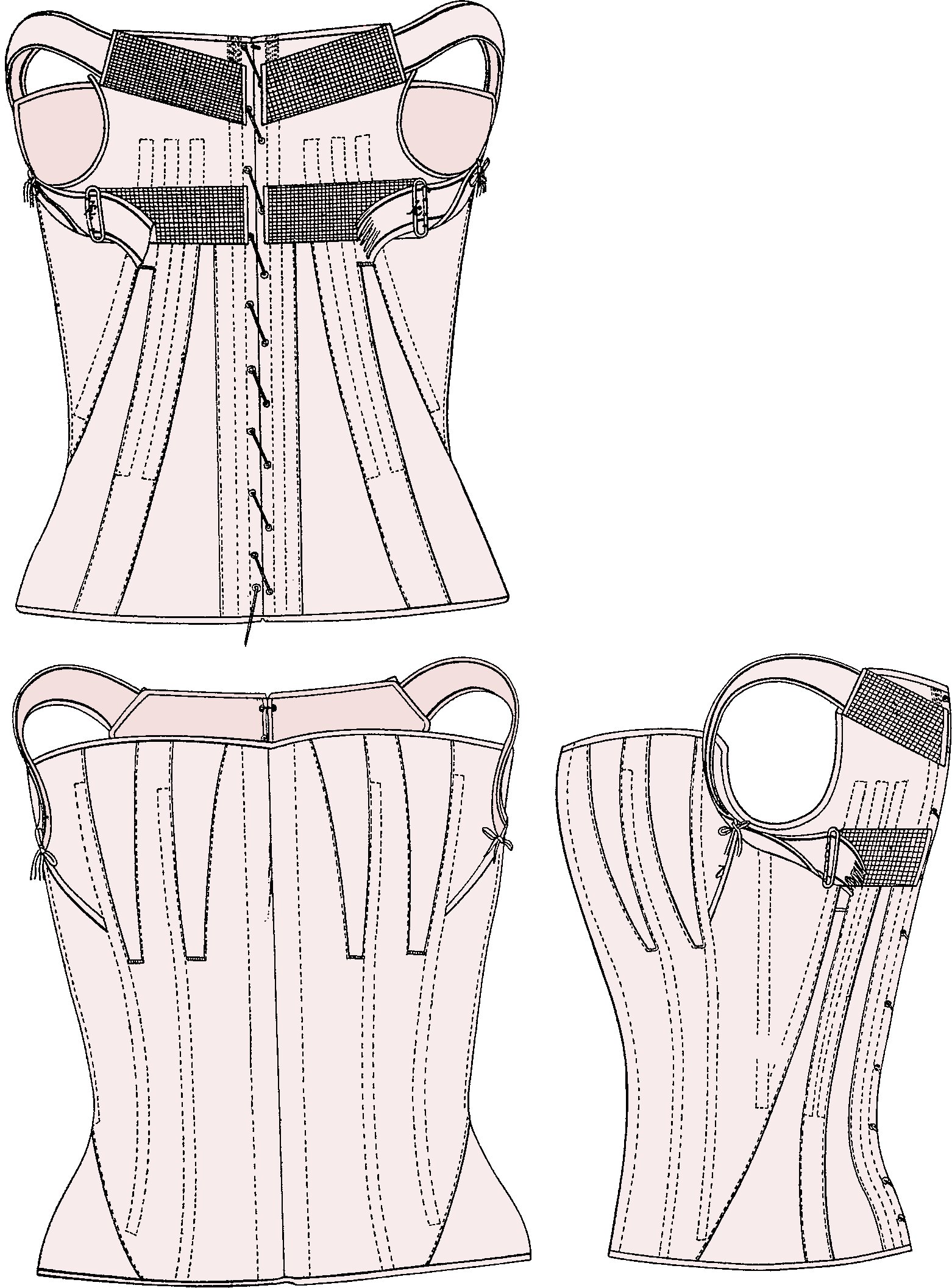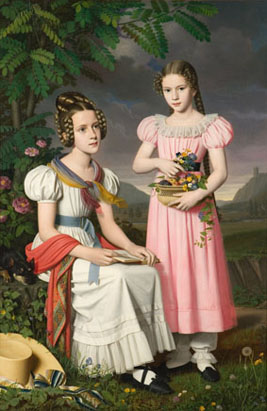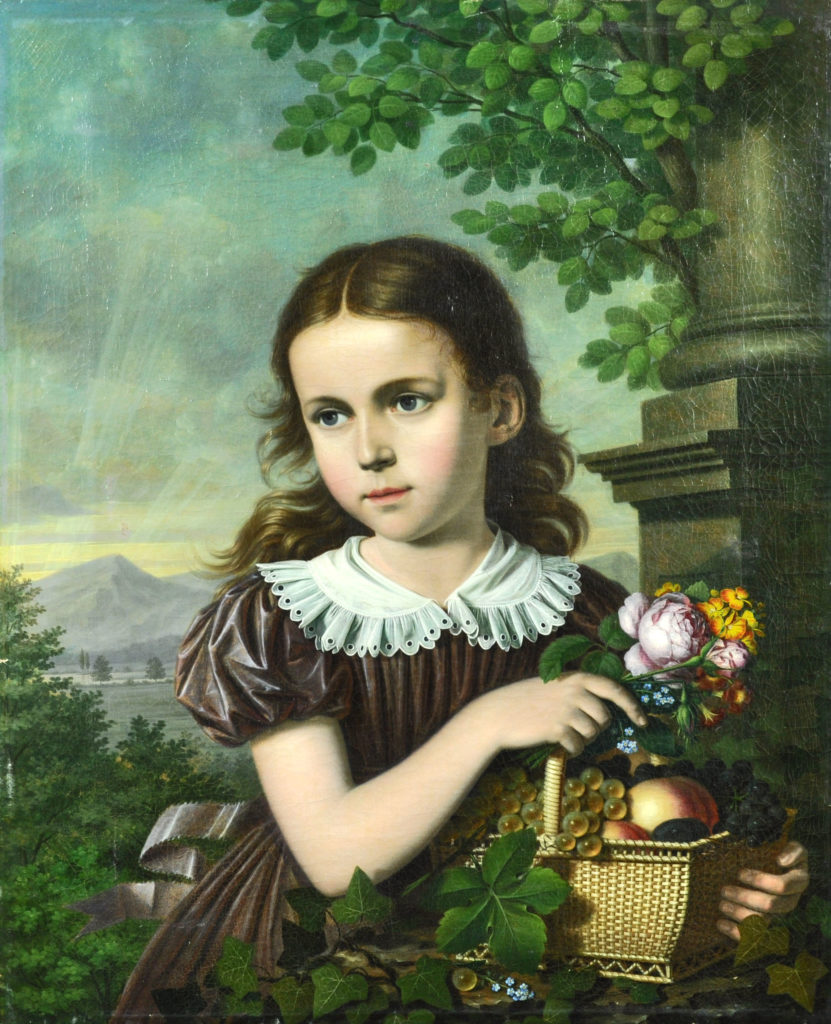
With the moniker “Girl-Cutter,” he fills the city with terror….
With these words, the Bavarian newspaper Rheinbayer spread goose bumps among its reading public. It was April 1835 and a serial criminal was on the loose. Augsburg called him the Mädchenschneider, or “girl-cutter.” He didn’t kill. Instead, he took his pleasure by slipping a knife out of his coat and slashing young girls. He was a serial stabber, or piqueur, who terrorized Augsburg from 1819 until his arrest in 1837.
What makes this case particularly interesting is how one young girl was spared from serious injury. She was saved by her corset. The annals of true crime are full of women whose corsets – and the steel or whalebone stays in them – saved them from knives and bullets. But most of these stories are from the late 19th and early 20th centuries. This is the earliest case I’ve found – and also the youngest victim saved by her corset. We’ll take a close look at her story, and then we’ll take a brief romp through other cases in which feminine fashion foiled the fiend.

Girl-Cutter of Augsburg
Augsburg’s girl-cutter typically attacked at night. Augsburg documented 39 attacks, but the perpetrator later admitted to 50. He stabbed his victims severely enough they required medical attention; some of them needed surgery. During the crime spree, women feared to leave their homes in the dark and men began to arm themselves.
Augsburg finally apprehended a vintner named Carl Bertle (sometimes spelled Bartle) in 1837 after someone recognized him. He confessed. Police found a variety of stilettos and knives in his apartment. Bavaria convicted Bertle and sentenced him to hard labor.
Brief sketches about the girl-cutter of Augsburg appear in psychiatric casebooks as an example of piquerism, the perverse sexual urge to penetrate the skin of others. The London Monster, who attacked women between 1788 and 1790, is another example of a piqueur.

Eight-year-old girl saved by her corset
The Bavarian newspaper article described an attack in 1835:
Augsburg, April 10. Yesterday morning at 10:00, six girls aged from about eight to ten years wanted to go to their sewing lessons with Madame Lesuire [sic]* in the Wintergasse [an alley]. They chose to take a shortcut through a frequently used passage by the garden of the brewery “Little Blue Tankard.” The path there isn’t very wide, so the girls had to walk in single file. The last one, the daughter of trade commissioner who has been gone on business trips for most of this year, was about to go through the little door that leads to the Hunoldsgraben [a street], when a man with green glasses and a black greatcoat, whom the other girls had likewise noticed, drew a cutting instrument from his coat and injured the poor child with a foot-long incision over her left armpit. Fortunately, her corset was made of particularly strong material so that the cut didn’t penetrate too deeply into her flesh. Although she bled severely, it wasn’t a gaping wound. Madame Lesuire, to whom the screaming girls ran, took the wounded girl immediately to the police, where all conceivable measures were immediately taken to catch the wretch, but unfortunately, the search has been fruitless.
Another source, Hitzig’s Neue Pitival, describes the wound as a light incision six inches long, leading from the left armpit to above the left breast. The victim was only eight years old. Although I was surprised that a girl as young as eight wore a corset, a period dictionary confirms that the German word used in the newspaper, Schnurleibchen, does indeed refer to a corset rather than a laced bodice.

The staying power of the corset: an overview of other cases
Here’s a snapshot of a few of the many other cases I found on the internet. Our eight-year-old girl wasn’t the only one saved by her corset!
1888, Barnsley, England. Mimi Matthews’ delightful history blog offers an example of an estranged husband who stabbed his wife after kidnapping their baby from her. He then invited her over to see the baby. When she arrived, he stabbed her. The stays of her corset were strong enough to break the blade – and save her life.
1890, Omaha, Nebraska. “Was saved by her corset,” reported the newspaper. William Schipp tried to shoot Dora Bowman in a lover’s quarrel, but the bullet struck her steel stay and fell to the ground. Schipp was convicted of assault and imprisoned.
1897, Troy, New York. “Saved by Her Corset Steel,” read the newspaper headline. A bullet deflected off a young woman’s undergarment and a young man admitted causing the shot while fooling around with a pistol. The strange part about the case was that he told the police the woman was his wife, and she denied knowing him. The man was arrested.
1897, Plainfield, New Jersey. A tramp entered the home of Mrs. A. Moebius while she was alone, preparing dinner, and demanded money. She refused. When she screamed, he stabbed her in the breast. Fortunately for her, the blade of the knife struck one of her corset stays and broke. She fainted and the tramp ran away.
1898, Wellington, New Zealand. One woman walked into a department store and shot her estranged business partner. The bullet ricocheted off the steel boning in the victim’s corset, leaving her alive to testify against the perpetrator.
1906, San Francisco. A stranger entered the rear of Mrs. George Alger’s house and tried to stab her. She told the police her corset saved her from injury and her screams drove him away.
1908, South Orange, New Jersey. Mrs. Edward H. Graves was saved by her corset when a neighbor cleaning his gun accidentally discharged it. She fainted. The physician who examined her determined that the bullet bounced off the steel in her undergarment.
1909, Chicago. Dr. Jennie A Beardsley, a physician, was stabbed twice in the breast and stomach when she answered a knock at her back door at night. “A steel ribbed corset saved her life,” the newspaper reported. The attack was part of a failed attempt at extortion.
1913, St. Petersburg, Florida. Two residents in a boarding house got into a row and one stabbed the other. The victim was saved by her corset, the newspaper wrote. “The blade of the knife, a vicious looking weapon, was broken by the force with which it was driven.”

No matter what their age, the women of the past had a message for criminals. No matter how feminine they appeared, they could be as tough as steel.
Do you know of any other cases of a crime victim saved by her corset?
Note:
* The teacher in the Girl Cutter case was Julie v. LaSuire, who appears in an 1859 Augsburg directory as an Arbeitslehrerin, or teacher of a trade. Her address was O. Hunoldsgraben 86.
Literature on point:
Rheinbayer, April 23, 1835, p. 195 (translation mine).
J.E. Hitzig, “Der Mädchenschneider in Augsburg,” Annalen der deutschen und ausländischen Rechtspflege 31:196-233 (1841)
Wilhelm Ludwig Demme, Das Buch der Verbrechen 281




What fascinating research. Putting an eight-year-old in a corset sounds rather cruel but it worked out well for that girl. Two of the London Monster’s victims were also somewhat saved by their corsets. Miss Toussaint’s dress was ruined in January 1790, but her whalebone corset stays saved her from harm. Miss Jane Hurd was less lucky in April 1788; the Monster managed to cut through the whalebone and injure her. Of course it would have been far worse without the corset.
How interesting, Karen! I suspected that the eight-year-old girl was not the first to be saved by her corset, but I didn’t have access to all the London Monster’s crimes. She may have been the youngest, though!
These corset incidents were probably pretty common in the annals of true crime history. Thanks for commenting!
As a civil war reenactor, I have had to wear a corset under my day dress! Of course I could not tolerate it because I wasn’t raised wearing one. Girls during the past centuries were started early learning to wear a corset while taking classes in deportment, drawing, dancing,singing, painting, embroidery, reading and writing. This was mostly for the upper classes. Women of the lesser classes also had to wear corsets but were not given access to those classes. Women then by the age og 15-16, were ” brought out into society” at a ball, it was for all intents and purposes ” a meat market”. Women were used as chess pieces or chattel in business deals by their fathers or guardians to secure land and business deals. After being seen the girls’ fathers would receive offers for their hand in marriage and the father decided which ” deal” would Give him the best standing in business and which association improved his standing in the community. There was usually no love involved, sometimes the girl did not even know her new husband, or even like him. Her job was to secure the family’s standing in the community by taking on this marriage and being a good wife to her new husband using all of the skills she learned. Imagine being a poor woman with hardly any money having had none of the finer things in life, wearing a corset while cooking, cleaning, and having children while wearing a tightly laced corset. She did not have the opportunities the rich women did so she sweated over laundry, and cooking while wearing one of those ” iron maidens” !
Thanks for your insights, MaryAnn. I can imagine a corset would be uncomfortable, especially if you are not used to it, and can also imagine they could get really hot in the summer. You sacrificed your comfort for authenticity in the Civil War reenactments, and for that alone, I tip my hat.
Or should I courtsey? 😉
It’s interesting that girls started out so early with their corsets. How knows? Maybe the Bavarian girl wasn’t the youngest victim to be saved by her corset.
Thanks for commenting.
I’ve been a Civil War reenactress for the past 15 years or so, and I blushingly admit that I avoided a corset for the first 10 of those years. However, since my menfolk were promoted into the ranks of Officers, I’ve had to morph my role into that of an Officer’s Lady and don a corset, as has my daughter. After having gone through a number of different patterns and makers (from Victoria’s Secret bits of frippery on up), I have to say that a poorly fitted, insubstantial corset is a waste of time, money and comfort. A well fitting corset made to fit YOU should feel like a snug hug, not like torture instrument. Women tend to be vain and if a bit of something is good, much more must be better. But in the world of corsetry, tighter is definitely NOT better. The purposes of a period corset were and are to 1) support the bust, 2) reshape (not compress) the waist from oval to circular, 3) support the back, and 4) support the weight of the petticoats and dress. I will unhesitatingly recommend The Paper Lady Corsets by Miss Mary Whisante for all your custom fit corseting needs (and no, I’m not related to her nor do I benefit financially). She’s on FaceBook. You have to learn to move a bit differently, and bend from the hips instead of the waist, but I can comfortably spend all day in her corset, as can my daughter. That said, if I’m going to be cooking over a campfire or doing lots of period laundry, I’ll opt for a corded corset instead.
Those are interesting insights, Catherine; thanks for commenting! What is a corded corset? Is that a corset that uses cords for stays? And what about your corset for reenactments — are the stays made of steel or some other material?
I dress as a Civil War officer for a city tour I give in Germany — both to make myself stand out as the tour leader and to empahasize the town history’s connection to the American Civil War. Of course I would never wear a corset for that, and I must admit I’ve come to admire the comfort of suspenders….
Have fun with your reenactments, and here’s to hoping you’ll never have need of your corset to protect you!
Ann Marie, the story you’ve uncovered and sleuthed out sounds fascinating! Thank you for writing the book and sharing the story with the rest of us. I look forward to buying a copy when it’s available.
Yes, I wear steel “bones”, and a corded corset uses thick ropes of cotton in place of the “boning”.
I jumped into the discussion when I stumbled across it in a “corset” search because I’m always sorry to see one person’s bad experience with a period garment presented as FACT, and then scare people away.
Just yesterday, a young lady of 17 joined us for her first historical event ever, and wore one of our corsets ALL DAY LONG. She looked lovely, and commented that the corset really was supporting her normally sore back and made it feel ever so much better! She’s not alone in that. I know many women who wear their corsets in real life when their backs are troubling them. 😉
As for your dressing as a man, so does my daughter. She first went out on a battlefield as a Vivandier. These ladies were initially Europeans, and were some of the first women to join a military unit in uniform. American observers of Napoleon brought the idea back to the U.S. These ladies were a sort of triage nurse/morale officer/sutler for their unit and wore a modified version of the unit’s uniform. This usually consisted of a knee length full skirts over matching trousers, and a trimmed down short jacket similar to what the men wore. My daughter dressed in similar fashion, had her canteens of water, her little barrel of brandy, tourniquet and strips of bandages in her haversack, and her little pistol, in case she needed to defend her wounded men. But what the soldiers appreciated the most was the fact that she noticed that orders weren’t being relayed effectively down the lines of soldiers, and took it upon herself to help out. After the battle, the entire unit praised her “carrying voice”, and asked that she lose the skirt and become a “man” on the line, so she did! She’s gradually risen through the ranks and is now a Sargent in our Unit. She enjoys the best of both worlds…a man by day on the field, and a lovely young lady by night in a ball gown. So, have fun with your own period cross dressing. You are right…the pants are usually worn a couple of sizes larger than we do now, and are quite comfortable as they usually are supported by suspenders instead of a pinching belt!
Thanks for your kind words about my book, Catherine. It’s slated for publication in the fall of 2017, and I’ll let you know per Email when it comes out.
That’s an interesting story about your daughter and the Vivandiers. I hadn’t heard of them before. What you and your daughter do sounds like so much fun, and if I were in the U.S., I’d love to watch your reenactments! Unfortunately, a severe allergy to horses keeps me from participating myself, up close.
As to the men’s uniforms, you are so right about the pinching belt. I never knew just how uncomfortable belts are until I got into those suspenders! The only thing I wonder about with my uniform is the wool — I know Civil War officers wore their wool in the heat of the summer — think of Gettysburg! — but I don’t think I can hold out. I don’t want to faint in the middle of my tour! The uniform is great for the spring and fall, though.
Well, I can’t share links here apparently. But the Independent News has an article from 1999 (it wasn’t THAT long ago, was it? Lol) entitled “Secret files tell of final terrors for Romanovs” and there are many other articles around, as well. I’ve got to quit wandering amongst them and get back to work! lol
Thanks for that tip, Catherine!
Actually, wool is a fascinating fiber. It’s both hydro-phobic and hygro-scopic. So it both repels water and absorbs up to 30% of it’s weight in humidity, so people actually tend to feel DRYER when wearing it! Lol. It’s insulating, so it can actually shelter your body from the heat of summer, as well as keep you warmer in winter. Wet wool can also cool the wearer as the dampness evaporates. The fiber is fire retardant, as well. In a time and place where most cooking was done over ground level open fires, errant breezes could blow skirts right in, making fire one of the major causes of female mortality on the American frontier. So where possible, frontier women tended to opt for wool or wool blended fabrics for their hard wearing and fire protective work clothes. And last but not least, wool has bacteriostatic properties, so it inhibits or kills the bacteria that make body odor. A dirty woolen garment can be aired overnight and then brushed thoroughly to release any dried on dirt. It will then both look and smell fresh and clean to be worn again, no dry cleaning involved!
Sorry about the dissertation on the benefits of wool…but it turns out our ancestors had reasons for much of what they did. I’m looking for some nice summer weight wool to make myself an 1860s dress and I’ll be happy to report back with any personal insights! lol.
As to your own apparel, when possible, you might want to invest in lighter weight wool suit for the warmer months? And remember, our ancestors had reasons why they wore layers. True linen is also hygro-scopic, absorbing and evaporating off quantities of perspiration, which is why it was so popular for dressing beds, and for personal undergarments. I hope this information helps. Please, don’t pass out on your tours, but you might just find that wearing what “they” wore isn’t all bad?! I hope to get a chance to follow your footsteps and listen to your stories one day. 🙂
OH! Last but not least, not all Living History events (aka Reenactments) have to involve horses. Our club portrays a DISMOUNTED Cavalry Unit, as it’s become too expensive for many of us to keep mounts. lol. Infantry are also free of equine participation. And it turns out that Germany (and Europe in general) supports a number of American Civil War events. I know that there are lots of Napoleonic events, and I’d be willing to bet there are any number of other time periods represented, as well…from Vikings to Romans to Vietnam era. I remember seeing American Indian Tipis set up in England with lovely 15th c. half timbered houses in the back ground! lol. Reenactments are a good way to “walk a mile” in someone else’s shoes. I hope you find one or some to attend that don’t bother your allergies.
I can see, Catherine, that I have a lot to learn about period clothing. A reenactment without horses would be fascinating to visit. The next time I’m in the U.S., I’ll contact you to see if anything might be available.
Thanks for offering all this interesting information on my post.
There’s always lots more for all of us to learn, no matter. Thanks for your wonderful posts, your fascinating story, and lovely conversation. Feel free to connect up whenever and wherever. Yours, Catherine
The 8 year old girl’s protection from serious injury by her corset is a curious anticipation of the incident in which a chicken wire ham costume saves 8 year old Scout from a murderous knife attack in Harper Lee’s “To Kill a Mocking Bird”. Lee may have known of one of the American examples given her interest in true crime.
“To Kill a Mockingbird” is my favorite novel, Ann, so I love your insight. All the work I put into the blog would have been worth it for just your comment alone. Now I have a new way to think about the Scout’s survival of the attack. Thanks so much for commenting!
There was a man in London in 1811 who went around stabbing at women. I can’t find the source where I first read this– which is very frustrating. I knew of the previous one in London as well. However, I wasn’t aware that it was such a widespread and known mental aberration.
Girls were put into stays and corsets from an early age to improve their posture and to train them to wear them in adult life. I don’t think most mothers or maids knew why this was so, they just knew that respectable girls wore them. In England, lower class girls could wear jumps instead of stays — which were expensive. An Austrian empress died when stabbed in the side . I think the knife went between the steel parts but the corset made it possible for her to walk and keep going for some time afterwards,
Thanks for commenting, Nancy! The Austrian empress you described was Elzabeth, or “Sissi.” When she was stabbed, no one — not even she — knew what happened. Her corset might have kept her from bleeding so much at first. Her wound was discovered only after she collapsed and was undressed.
The 1811 case sounds interesting — yet another piquer! If you happened to run into sources, please let me know.
Some of the women who were stabbed in the other cases I listed were victims of attempted murder and didn’t involve piquerism. But that doesn’t matter to the corset! It will deflect blows either way.
What are the jumps that lower class girls would wear? I’ve never heard of them.
Loved this post, Ann! (And thanks for the kind mention!) There are so many horror stories associated with 19th century fashion–especially corsets. It is always a refreshing change to read the true accounts of fashions that saved lives.
Thanks, Mimi! It’s nice not only to reflect on the lighter side of true crime, but also the lighter (or should I say hard-as-steel) side of corsets.
And then there is a more horrific side, as well. The Romanov ladies sewed their jewels into their corsets, intending them to fund their lives in exile. Instead, they accidentally made themselves flack jackets that just lengthened the time it took for their murderers to kill them.
Good point! I’ve read that about the Romanovs as well. Their deaths must have been horrible.
Apparently there are many documents being declassified. King George of England knew for sure that his cousins were murdered within 2 days, and how, but didn’t want the grisly details to become tabloid fodder and had the records sealed.
Apparently, the Russians and Brits have shared declassified files, about Nazi Germany’s final days, and about the Tsar and his family. One document was the “after action report” of the Lead Murderer on how things went down and how badly the Bolsheviks botched the jobs of “liquidating” the Imperial Family, as well as finally burning and burying them.
The murder itself took over 20 minutes. The gunmen had to get themselves drunk on vodka to even begin, and then many freaked with bullets flying around the small room, bouncing off diamond lined corsets, and off of the brick walls of the basement. The Tsar and Tsaritsa died immediately, but not so the rest of the ladies. For example, the maid was running around screaming her head off before she finally died with 32 bullet holes. The Tsarevich was apparently the last to die, sitting stunned and immobilized in his chair with horror all around before he was dispatched. The gunmen stumbled out of the cramped basement afterwards and started throwing up in the snow outside.
Oh, it just makes my heart sick. I keep wanting to rewrite their story with a happier ending in this life. Apparently, among the Tsar’s last words were something like “At last, we are leaving here and going to a better place”. The Eastern Orthodox Church considers him a Saint for the faith of that statement, so I pray that they did get their happier ending in the next life.
The horror the Romanovs must have endured is inconcievable, especially considering how the girl’s corsets protected them and only prolonged their misery. I’ve been toying with the idea of blogging about the Romanovs, but want to pick up decades later with the discovery of their bodies. That basement is a place my mind doesn’t want to linger. But — do you know if any of those declassified documents are online? If so, I’d love a link, if nothing else as a reference.
Thanks for commenting, Catherine!
Well, there is a movement amongst some to return to wearing corsets. I certainly would benefit from the form shaping enhancement. And now, protection from attacks?
Something to ponder…
Love this article and its delicate peek into history. The little details of life in another time are fascinating.
Thanks so much, Leslie. One Civil War enactor told me she actually felt more comfortable in a corset than a bra. Are we modern women missing out on something?
A young girl having to wear a corset doesn’t surprise me because a long time ago for a psychology class I read a book called “The History of Childhood” and for the majority of the time it seems, children weren’t thought of as children at all, but as little adults. They were expected to dress, behave, and look like adults. I’m glad that the corsets were actually useful though, enough to even save lives! I think it would be wonderful if you were to write about the Romanov family, I’ve been interested in them ever since 1972 when I think the movie came out on them, I am surprised though by the number of lives saved by corsets and I wouldn’t be surprised if there were more cases but they just didn’t get documented. Very interesting, thank you!
I’m glad you found the post interesting, Susan, and thanks for commenting. I tried to interview an author of a book about the Romanovs, and although he initially expressed interest, he never responded to my questions. There are a few good books out there about the Romanovs, though.